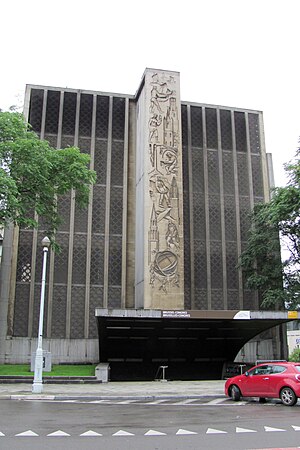Brussels Congress railway station
|
Brussels Congress
|
|||||||||||
|---|---|---|---|---|---|---|---|---|---|---|---|
 |
|||||||||||
| Location | Pachécolaan n°25, 1000 Brussels Belgium |
||||||||||
| Coordinates | 50°51′08″N 4°21′43″E / 50.852222°N 4.361944°E | ||||||||||
| Owned by | Belgian Railways | ||||||||||
| Operated by | Belgian Railways | ||||||||||
| Tracks | 4 | ||||||||||
| History | |||||||||||
| Opened | 4 October 1952 | ||||||||||
| Traffic | |||||||||||
| Passengers (2010) | 1,500/weekday | ||||||||||
| Services | |||||||||||
|
|||||||||||
Brussels Congress is a train stop on the North-South connection in the city of Brussels, Belgium. It is located on the Pachecolaan. Opened in 1952, it served as a train station for 50 years. In 2002 the ticket offices closed and it was downgraded to a train stop. With only few passengers a day using Brussels Congress plans were being made to close it completely. However up to now (31 May 2014) none have been executed.
Brussels Congress opened as a station in 1952 as part of the subterranean North-South connection. It served as a ventilation shaft for the connection, which was then still used by steam trains. In 1958 the construction works of the Rijksadministratief Centrum started, a building which was to accommodate all of the country's administrative services. The construction took 27 years and the building, at its peak, could accommodate 14,000 civil servants. Consequently, the Congress station became of significant importance for the commuting workers. However, with the rise of workers commuting by car, and later on the abandonment of the RAC building, the station got more and more out of use.
Since April 2002, when the ticket offices closed, it has only been in use as a train stop. In 2009 the Belgian Railways counted 1187 people boarding at Brussels Congress every weekday. In 2010 this number was said to be 1499. Even though the number of passengers increased, it remains very low. With the number of passengers being so low and several other transportation facilities being available in the vicinity, the Belgian Railways are thinking of closing the Brussels Congress train stop completely, this mainly to improve the accuracy of the trains on the North-South connection. However, no final decision has been communicated yet.
The station was designed by modernist architect Maxime Brunfaut at the end of the 1940s. The station building exists mainly of an above-ground ventilation shaft for the underground North-South connection, which Brunfaut smartly used as the basis for his monumental design. The main design features are the stumpy tower and the large cantilevering shed over the entrance. The tower is five floors high and exists of a central bay sticking out of the front facade, housing the service stairs, and six bays to each side of this central one. The facade of the central bay is closed. The front facade of the other bays forms a rhombic net made from terracotta. This net is continued on the highest floor of the side facades. The lower floors of the side facades are closed. On both side facades bas-reliefs have been applied. The closed front facade of the central bay is also decorated with a bas-relief, made by Jozef Cantré. The underground entrance is accentuated by the large cantilevering shed with the station's name written on its edge.
...
Wikipedia
